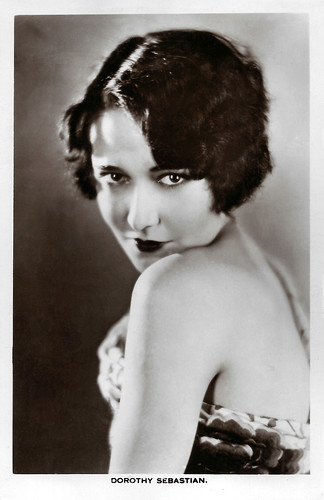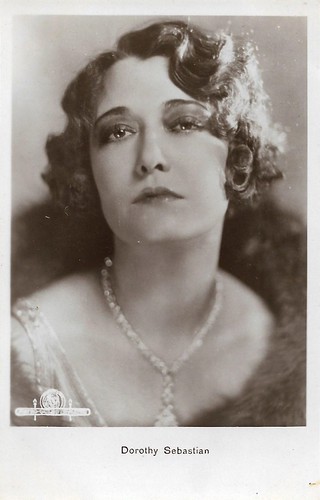
Dutch postcard, no. 146. Photo: Metro-Goldwyn-Mayer.

Swiss-German-British postcard by News Productions, Baulmes / Filmwelt Berlin, Bakede / News Productions, Stroud, no. 56558. Photo: MGM / Collection Cinémathèque Suisse, Lausanne. Caption: Joan Crawford & Dorothy Sebastian, Santa Monica, 1929.

German postcard by Ross Verlag, no. 5362/1, 1930-1931. Photo: Metro-Goldwyn-Mayer. Dorothy Sebastian and John Gilbert in A Woman of Affairs (Clarence Brown, 1928).

British Real Photograph postcard in the Picturegoer Series, London, no. 374a.
Friends with Greta Garbo
Dorothy Sebastian was born Stella Dorothy Sabiston in 1903 in Birmingham, Alabama. She was the daughter of clergyman Lycurgus (Lawrence) Robert and Stella Armstrong Sabiston, who was an accomplished painter of portraits and landscapes. In her youth, she aspired to be a dancer and a film actress. Her family frowned on both ambitions, however, so the curly-haired brunette fled to New York at the age of 15. After leaving Alabama and starting a career on the stage, Dorothy changed the spelling of her name to Sebastian.
In 1924, Dorothy Sebastian did a few appearances as a dancer and chorus girl in the revue 'George White's Scandals', a long-running string of Broadway revues produced by George White that ran from 1919–1939, modeled after the Ziegfeld Follies. After that, she went to Hollywood in 1925 with a seven-year contract at MGM. After a few minor roles, she became a popular supporting actress during the transition from silent to talkies. She played opposite Raymond Griffith in the murder mystery You'd Be Surprised (Arthur Rosson, 1926).
Then followed the drama The Isle of Forgotten Women (George B. Seitz, 1927) with Conway Tearle, and the Westerns California (W.S. Van Dyke, 1927) with Tim McCoy and The Arizona Wildcat (Roy William Neill, 1927) with Tom Mix. Much to her chagrin, as her career went on she was often cast as vamps or, at least, disreputable or hard-boiled 'other women'.
The following year, she appeared in the drama The Haunted Ship (Forrest Sheldon, 1928) with Montagu Love and Tom Santschi and the comedy Their Hour (Alfred Raboch, 1928) with John Harron. With Tim McCoy, she reunited in the Westerns Wyoming (W.S. Van Dyke, 1928), The Adventurer (Viktor Tourjansky, 1928), and Morgan's Last Raid (Nick Grinde, 1929).
In 1928, during the shooting of A Woman of Affairs (Clarence Brown, 1928), she became friends with Greta Garbo. While she had already had bit parts in two earlier films with Garbo, and after the supporting role in A Woman of Affairs, she would be 'the other woman' opposite Garbo in the romantic drama The Single Standard (John S. Robertson, 1929), also with Nils Asther and Johnny Mack Brown.

Russian postcard by Goznak, Moscow, series no. 5, no. A 4711, 1928 Published in an edition of 25,000 cards.

German postcard by Ross Verlag, no. 4265/1, 1929-1930. Photo: MGM. Collection: Marlene Pilaete.

Austrian postcard by Iris Verlag, no. 6047. Photo: Metro-Goldwyn-Mayer.
Slam-Bang-Bastian
In 1928 Dorothy Sebastian appeared alongside Joan Crawford and Anita Page in Our Dancing Daughters (Harry Beaumont, 1928), about the "loosening of youth morals" that took place during the 1920s. It was followed by Our Modern Maidens (Jack Conway, 1929) and Our Blushing Brides (Harry Beaumont, 1930) with the same three actresses.
In 1929 Sebastian appeared in the silent comedy Spite Marriage (Edward Sedgwick, Buster Keaton, 1929), where she was cast opposite the then-married Buster Keaton. They began an affair, during which they both became notorious for their alcoholic excesses. At this time she also got her nickname Slam-Bang-Bastian or Slam, because she used to become unruly and abusive when drunk.
At the end of her five-year contract with MGM she asked for a raise (her weekly salary amounted to $1,000 per week), but was refused. Out of a contract, her film career faltered after several "Poverty Row" productions at Tiffany. In 1930 she married Western star William Boyd, with whom she had starred in the comedy action film His First Command (Gregory La Cava, 1929). Initially, Sebastian's passage to sound film seems to have had no impact on her career, as she continued to have the female leads in many films at MGM, Columbia and RKO, including several with her husband William Boyd and with Lloyd Hughes.
Yet from 1931, her increasingly uncontrolled alcoholism drastically reduced her career, and Dorothy Sebastian only appeared in a succession of B-movies, although she had the female lead in the Columbia serial The Mysterious Pilot (Spencer Gordon Bennet, 1937) and had a supporting part as a saleswoman in the famous film The Women (George Cukor, 1939), starring Norma Shearer and Joan Crawford. Sebastian had her last onscreen appearance in the drama The Miracle of the Bells (Irving Pichel, 1948) starring Fred MacMurray, Alida Valli and Frank Sinatra.
Sebastian's marriage to Boyd ended in divorce in 1936. Before Boyd, Sebastian had already been married four years (1920-1924) to her high school sweetheart, Allen Stafford. During the war years Dorothy worked as an X-ray technician at a defense plant, Bohn Aluminium & Brass, but continued to act in small parts. In 1947, she married Miami Beach businessman Harold Shapiro, to whom she remained married until her death from cancer ten years later. Dorothy Sebastian passed away in 1957 in Woodland Hills, Los Angeles, California. She is buried at Holy Cross Cemetery in Culver City, California. She has a star on the Hollywood Walk of Fame on Hollywood Boulevard.

German postcard by Ross Verlag, no. 4141/1, 1929-1930. Photo: Metro-Goldwyn-Mayer. Dorothy Sebastian and Nils Asther in Our Dancing Daughters (Harry Beaumont, 1928).

Belgian postcard by P.I.A., Belga phot., Bruxelles. Photo: Metro-Goldwyn-Mayer.

French postcard by Cinémagazine-Editions, no. 687. Photo: GMG (Gaumont-Metro-Goldwyn).
Sources: I.S. Mowis (IMDb), Wikipedia (English and German) and IMDb.
No comments:
Post a Comment